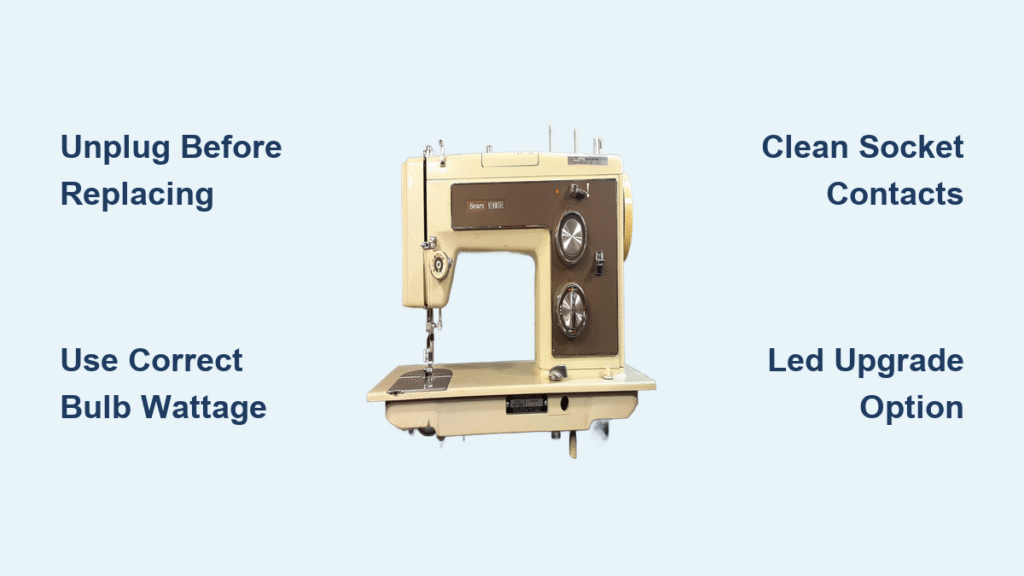Your Singer sewing machine suddenly skipping stitches on delicate silk? Thread snapping every few inches while quilting? These frustrating issues often stem from misaligned hook timing—the critical synchronization between your needle and rotary hook that captures thread loops to form perfect stitches. When this timing drifts even 0.5mm off spec, you’ll battle thread nests, broken needles, and ruined projects. I’ve seen countless sewists mistake timing problems for tension issues, wasting hours rethreading only to face the same disaster. But here’s the good news: You can fix this yourself in 15 minutes with basic tools. This guide delivers the exact adjustment steps for modern and vintage Singers, including the notoriously tricky 16-41 model. No more guessing—you’ll diagnose, correct, and verify proper timing like a professional technician.
Spot Your Singer’s Timing Trouble Signs
Skipped Stitches or Needle Strikes? Confirm Timing Issues First
Don’t jump into adjustments yet—verify timing is your culprit. Watch for these telltale signs: skipped stitches appearing randomly across lightweight fabrics, the distinct “clunk” of needle hitting the bobbin case, or thread snapping mid-seam despite correct tension settings. Crucially, if your machine runs but forms zero stitches while making that awful “thwip-thwip” sound, timing has likely shifted. These symptoms differ from tension problems because they persist after rethreading and changing needles. For absolute confirmation, perform the handwheel test: Turn the handwheel slowly counterclockwise while watching the needle descend. The hook point must catch the thread loop precisely when the needle rises 2.2mm from its lowest position. If it misses this window, timing adjustment is essential.
Avoid Misdiagnosis With This Prep Checklist
Before touching any screws, rule out simpler fixes. Install a brand-new size 90 needle—bent or worn needles mimic timing failures. Ensure your bobbin is inserted correctly with the thread tail exiting in the proper direction (clockwise for most Singers). Clean all thread nests from the bobbin area using a small brush; lint buildup can obstruct hook movement. Test with cotton thread on quilting-weight cotton fabric—delicate threads or slippery fabrics exacerbate minor timing errors. Only proceed if skipped stitches persist after these checks.
Prepare Your Singer for Precision Timing Work

Critical Disassembly Without Damage
Working on an unprepared machine risks costly errors. Unplug your Singer immediately—mechanical models can lurch unexpectedly. Remove all thread from the machine, including stray fibers in the tension discs. Now disassemble methodically: First, remove the needle plate screws and lift the plate straight up. Next, extract the bobbin case completely—don’t force it if stuck. For better visibility on models like the Singer 4423, remove the feed dog mechanism by loosening its mounting screws. Keep a magnetized tray for tiny screws; vintage models often use non-standard sizes.
Safety Protocols Most Sewists Ignore
Document every step with smartphone photos—snap shots of wire connections, screw positions, and gear alignments before disassembly. This creates your “undo” guide if adjustments go wrong. Mark original hook positions with a fine-tip paint pen on the hook race and drive gear. Never force stuck components; apply a single drop of sewing machine oil to seized screws and wait 10 minutes. Crucially, test motor direction on vintage models before reassembly: With the handwheel exposed, briefly power on the machine—the wheel should rotate counterclockwise (toward you) when viewed from the right side. If it spins backward, you’ll need motor rewiring—a critical step for Singer 16-41 owners.
Position the Needle for Perfect Timing

Hit the Exact 2.2mm Rise Point
Your needle’s position during adjustment is non-negotiable. Set your Singer to straight stitch with the needle centered—zigzag settings alter timing mechanics. Turn the handwheel counterclockwise until the needle reaches bottom dead center (its absolute lowest point). Now, raise the needle precisely 2.2mm using a digital caliper or two stacked dimes (total thickness 2.2mm). Most modern Singers (301, 4423, Curvy) require this measurement, but vintage models like the 16-41 need 2.5mm—measure with a ruler against the needle clamp. Hold the handwheel firmly; any slippage ruins accuracy.
Why Needle Quality Makes or Breaks Timing
Never adjust timing with a used needle—microscopic bends throw off measurements. Insert a new size 90 needle with the flat side facing backward, pushing it all the way up into the clamp before tightening. Verify straightness by rolling it on glass; even a 0.1mm bend causes false readings. If your Singer uses European needles (like some Industrials), confirm compatibility—wrong needle types prevent proper hook clearance.
Align the Hook Mechanism in Three Moves
The 30-Second Hook Adjustment Technique
Locate the hook gear securing screws—typically two or three Allen-head screws on the hook race housing. Loosen them just enough to allow hook rotation (¼ turn max)—over-loosening shifts internal gears. Now, rotate the hook clockwise by hand while watching the needle eye. Stop when the hook point centers directly behind the needle shaft, positioned 1mm above the needle eye. This “sweet spot” lets the hook catch the thread loop cleanly. For rotary hooks (modern Singers), the point should align with the needle’s centerline; oscillating hooks (vintage) need slight forward offset.
Lock Timing Without Shifting
Tighten the hook screws in a star pattern—alternate between screws while holding the hook steady with needle-nose pliers. Apply even pressure; uneven tightening warps the assembly. Now test rotation: Turn the handwheel slowly through one full revolution. The hook should glide past the needle without contact, catching an imaginary thread loop at the 2.2mm rise point. If you hear scraping, repeat the adjustment—hook-to-needle clearance must be flawless.
Fix Vintage Singer 16-41 Timing Flaws

The 1/16″ Shuttle Hook Rule
The 1892 Singer 16-41 operates differently. After setting the needle 2.5mm above bottom dead center, the shuttle hook tip must sit 1/16″ above the needle eye—about the thickness of a nickel. This CB (central bobbin) system uses a shuttle that rocks side-to-side, not a rotary hook. Align the shuttle hook point centered on the needle with zero side-to-side play. If your machine has the original motor, note its clockwise rotation away from the operator—modern motors spin oppositely, causing backward stitching.
Reverse Motor Direction Safely
Swap the field winding wires at the motor terminals to correct rotation (mark wires first!). After rewiring, adjust the feed cam on the top shaft: Loosen its setscrew, rotate the cam until feed dogs move fabric forward when the needle rises, then retighten. Test with scrap fabric—if stitches form backward, rotate the cam 180 degrees.
Validate Your Timing Fix Immediately
Reassembly That Prevents New Problems
Reinstall components in reverse order: Feed dogs first (aligning with needle holes), then the bobbin case (ensuring the spring latch clicks), and finally the needle plate. Tighten all screws finger-tight before final tightening—overtightening strips threads in aluminum housings. Before plugging in, turn the handwheel 10 full rotations to confirm smooth operation. Listen for grinding; any resistance means recheck hook clearance.
The 5-Minute Stitch Test That Works
Sew on muslin scrap using contrasting thread for visibility. Perfect timing shows consistent, locked stitches with no skipped points. After 5 minutes, check the bobbin case—no thread nests should form underneath. If stitches skip:
– Re-measure the 2.2mm needle rise point
– Verify hook rotation direction matches your Singer model
– Inspect the hook point for burrs (smooth with emery cloth if needed)
Retighten hook screws after 30 minutes of sewing—they often settle during initial operation.
Stop Recurring Timing Issues for Good
Post-Adjustment Habits That Last
Replace needles every 8 hours of sewing—dull needles stress timing mechanisms. After heavy fabrics like denim, recheck timing; dense materials force hooks out of alignment. Clean the hook race weekly with a small brush dipped in machine oil; built-up lint pushes hooks off-spec. If timing drifts repeatedly, replace worn hook drivers—common on Singers over 20 years old.
When to Call a Professional
If skipped stitches persist after three adjustment attempts, stop immediately. You likely have worn hook gears or bent shafts requiring specialized tools. Vintage Singer specialists charge $50-$75 for timing fixes—worth saving your machine from further damage. Never force adjustments; precision matters more than speed.
Proper hook timing transforms your Singer from a thread-breaking headache into a reliable stitching partner. By mastering this 15-minute fix, you’ll save hundreds in service fees and reclaim hours lost to seam ripping. Remember: Perfect alignment happens at 2.2mm needle rise for most models—measure twice, tighten once. Keep this guide handy for your next timing crisis, and share your success in the comments!




